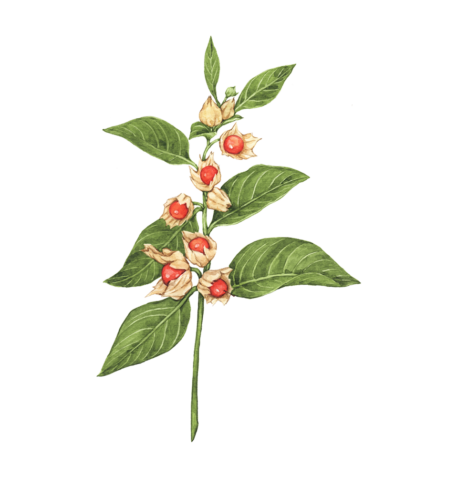by Lyssa Delgado

Welcome to my weekly article, The Heretic's Herbiary! In this weekly article, I will be discussing different herbs and plants and their connections to witchcraft through different cultural histories. I will be taking requests for herbs to cover, and this week will be an herb associated with the medicinal plant ashwagandha, as requested by Ailis Armstong!
The Ashwagandha herb is a staple of Ayurveda. In other words, it is one of the most popular Ayurvedic herbs; also going by the names Witharia Somnifera (in Latin) or Asgandh (in Sanskrit). This is an ancient medical ‘adaptogen’ herb since it eases stress. Further, you can steer clear of all forms of illnesses through regular use. For instance, it calms the brain, lowers inflammation, and strengthens immune health, among other benefits.
This plant is a small evergreen shrub which grows in hot and tropical climates. A Sanskrit word that means “smell of the horse,” Ashwagandha is a plant native to India, the Middle East, and North Africa. It grows on a small shrub that has yellow flowers and red fruiting bodies. True to its name, this magical herb is believed to provide strength and vitality. The roots and berries of this plant are of use to traditional medicines. Similarly, the leaves and seeds have certain uses as well. However, now you can conveniently obtain in through its powdered form.
The Hindu philosophy talks about five tattvas or elements that are present everywhere. These tattvas, namely earth, water, air, fire, and sky, are essential for one’s health provided it is in balanced form. Ayurveda believes that our body and mind have biological energies or dosha. These doshas govern our physical and mental well being. Ashwagandha is useful to revitalize these energies and maintain the balance of the tattvas by supporting healthy muscles, the nervous system, and the reproductive system.
With a use history that dates back over 6,000 years, ashwagandha is one of the most highly valued and traditionally used herbs in Ayurvedic medicine. In its earliest ancient text appearances, the plant is noted for its benefit in emaciation for people of all ages (including babies), its power to enhance the reproductive system, and its benefit for arthritic and rheumatic inflammation.
The Maasai people of southern Kenya and northern Tanzania use juice made from ashwagandha leaves for conjunctivitis, and fresh bruised berries applied topically for ringworm. In Lesotho, ashwagandha bark infusion is used internally for asthma and externally for bedsores. The tender shoots are commonly eaten as a vegetable in India.
Revered for its adaptogen properties, it relieves stress, anxiety and depression. Ashwagandha supports healthy nervous system function by helping the brain produce the neurotransmitter GABA, which promotes calmness. It has also been shown to stabilize cortisol levels; regulating this stress hormone boosts immune function and supports the adrenals. Ashwagandha can also be worked with magically for energy, strength and endurance. In powdered form, you can add to smoothies or baked goods!
Overall, it is plant with strong medicinal properties moreso than charms and spellwork, so even the skeptics amongst us can find a wonderful use for it!
That's it for this week's Heretic's Herbiary! Remember to comment with an herd or plant you'd like to see in the article next time! Have a magical day!

Contact
Site Jobs
Code by Bah